Dubai - math and science
By Murray Bourne, 09 Jun 2008
A thousand years ago, the Arabic world was amongst the most advanced in science and technology. It was certainly more progressive than Europe, which had already descended into its Dark Ages.
I enjoyed seeing some evidence of early scientific endeavour on my recent trip to Dubai.
Below is a window in one of the historical buildings in Dubai (not 1,000 years old, of course). The pattern reminds me of some of Escher's designs.
Islam forbids any images of Muhammed or Allah, so Islamic art evolved into something that was quite geometric in nature. See also Math of the Moors.
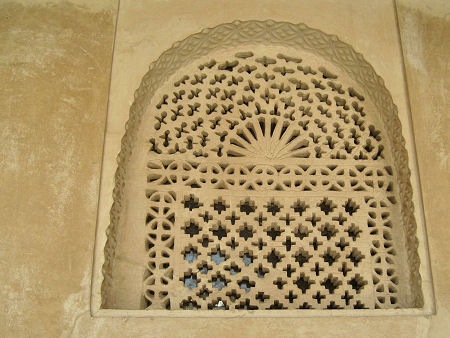
Eastern Arabic numerals are those used by Arabic speakers today. They are a forerunner of our 1, 2, 3, ... number system (called the Hindu Arabic number system).
This number plate has Western numbers on the left and the Eastern Arabic numerals 66915 on the right (written left to right). Notice that the number 6 in Arabic looks more like our 7, and their 5 looks more like our 0.
While words in Arabic are written right to left, the numerals are written left to right.
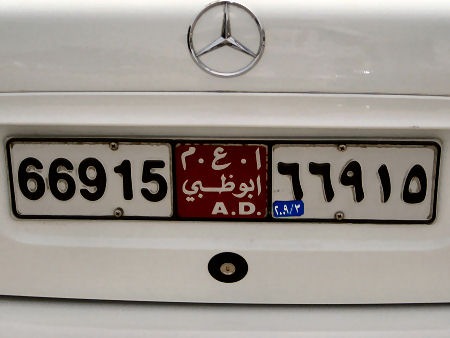
Here's a computer keyboard with Arabic characters.
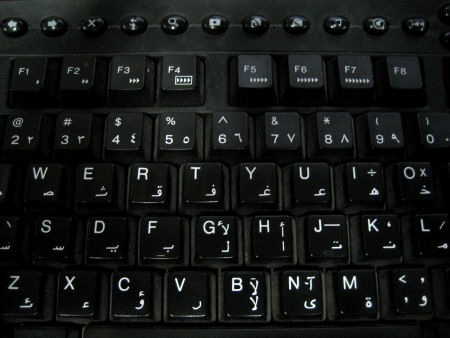
The following sign has some interesting calendar math. On the second last line, you can maybe make out "24" (about 1/3 of the way in, reading right to left) and 1427 is found 2/3 the way in.
"Hijri" is the Islamic dating system, which starts from 622 in the Western calendar (the year Muhammed went from Mecca to Madina).
In the Hijri calendar, today is Monday 5 Jumaada al-THaany 1429 A.H..
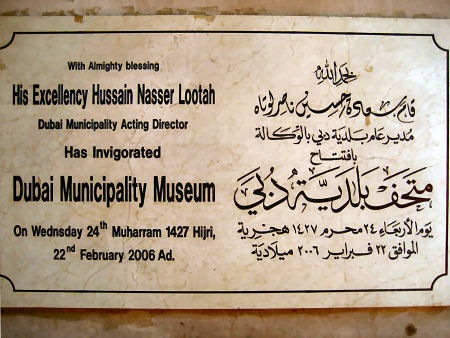
Here's a sun dial on the grounds of a mosque next to Dubai Creek. Dubai is currently building the largest sundial in the world.
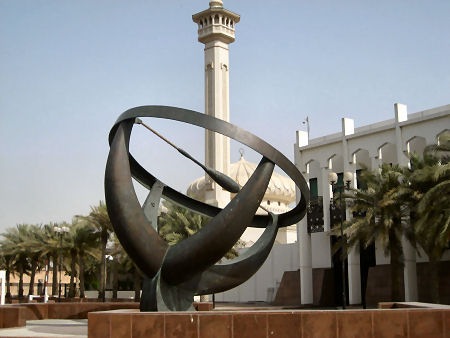
Since Dubai is all sand, the only way they could build anything solid in the early days (according to the museum captions) was to use "sea rocks".
Sadly, these "sea rocks" included coral. One wonders how many reefs were destroyed before they started importing steel, rocks and cement.
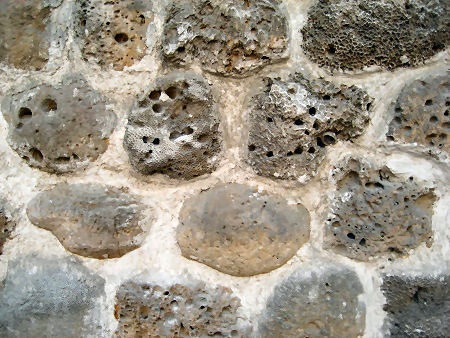
Following is an astrolabe in a museum near Dubai Creek. The astrolabe was used by the Arabs for...
... astronomical studies, as well as in other areas as diverse as astrology, navigation, surveying, timekeeping, Salah prayers, and Qibla. [Source]
"Salah prayers" are the obligatory daily prayers, and "Qibla" means the direction to Mecca. An intricate science was developed by Islamic scholars to determine the exact direction towards Mecca, as it was vital for daily prayers.
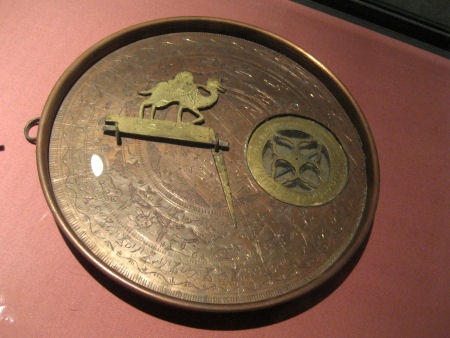
The following 2 photos are of a more impressive astrolabe that was in a hotel near the Burj al Arab hotel.
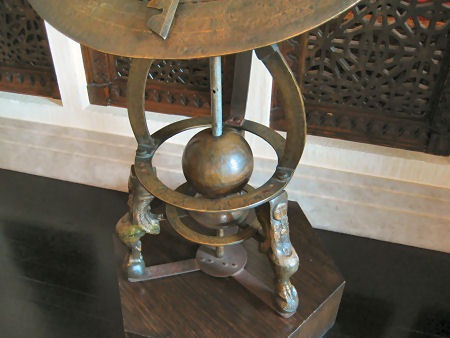
Detail of the astrolabe.
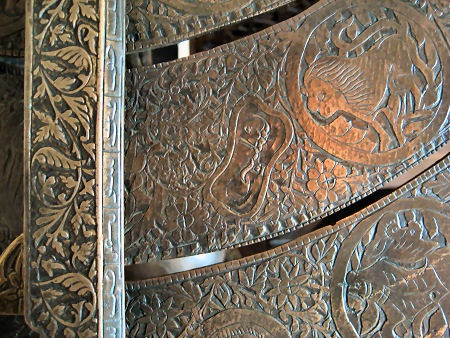
To finish, here is an interesting mix of old and new - satellite dishes on top of an old building near the Gold Souk.
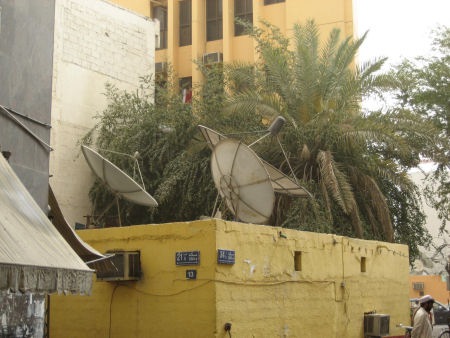
It is sad that religious fundamentalism tends to be anti-science. Such thinking is not confined to portions of the Muslim world - witness the debate over evolution by the Christian right wing in America and other Western countries.
Fortunately, Dubai has put education in science and technology high on its list of priorities.
You can see the other photo spreads in the Dubai series here:
See the 8 Comments below.
9 Jun 2008 at 10:10 am [Comment permalink]
Perhaps it's not so much that numbers in Arabic are writen left-to-right, as that they are written right-to-left with the least significant digit first? =)
9 Jun 2008 at 2:34 pm [Comment permalink]
Hi Brent. Actually, I was wondering about the same thing. We do actually write numbers right to left in the sense that we right-align numbers when adding them and add units first (on the right).
So good point.
We actually read numbers left to right, of course.
10 Jun 2008 at 12:47 am [Comment permalink]
Hi... If I may correct you.
You mentioned "Qilba" in the middle of your post. The correct term is "Qi'blah", the direction towards Mecca.
Also, readers might be interested to know the Arabic term "souk" means "shop" or place of business.
Just FYI.
10 Jun 2008 at 9:06 am [Comment permalink]
Hi Del and thanks for your input.
I actually have "Qibla" (not "Qilba"), which is the transliteration given by the Wikipedia article that I quoted from.
According to Google, the number of Web pages that use the different forms of the word (in decreasing order of occurrence) are:
Qibla 848,000
Qiblah 700,000
Kibla 493,000
Qi’blah 85,000
Kiblah 63,000
Seems that "Qibla" is the most common transliterated form - but "most common" doesn't necessarily mean "most correct".
Thanks again for your updates.
5 Nov 2008 at 11:53 pm [Comment permalink]
Hello everyone,
Dal you are right because the word "Qibla" should not be spelled like this "Qilba". It should be spelled like this: "Qibla". The word "Qilba" is above the "Qibla" photo. Please change the to the word.
Thank You.
6 Nov 2008 at 8:54 am [Comment permalink]
Hi Maddy. Oops - I missed Del's point before. The word was written twice and close together, the first one was correct but the second was incorrect.
Doh!
I have fixed the second one as suggested. Thanks for the feedback.
7 Mar 2010 at 3:21 am [Comment permalink]
Just wanted to correct you.
The red part of the license plate where you’ve said those 3 characters are numbers… they aren’t.
They are arabic letters. They are:
Meem – A’in – Alif
They may look similar but I assure they aren’t. And thats an Abu Dhabi license plate xD. Though I can imagine quite a few of those around Dubai.
7 Mar 2010 at 9:23 am [Comment permalink]
Thanks, Samaritan. I have updated the post.
Well, they looked like Arabic numbers to my inexperienced eye!
[Explanation: I originally wrote that the first 3 characters with red background were Arabic numerals...]